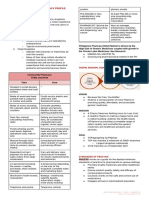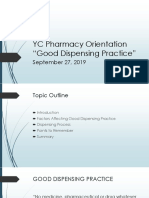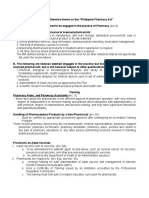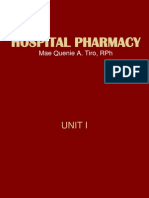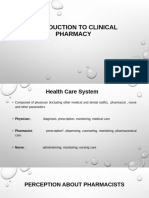100%(3)100% found this document useful (3 votes)
1K viewsDispensing and Medication Counseling
Dispensing and Medication Counseling
Uploaded by
LeiThe document discusses the important role of pharmacists in dispensing medications and providing patient counseling. It describes how pharmacists dispense medications by taking prescriptions, preparing and labeling the drugs, and delivering them to patients. A key duty is counseling patients to ensure safe and effective medication use. The counseling covers topics like dosage instructions, side effects, drug interactions, and storage. The goal is to improve patient outcomes, quality of life, and healthcare costs by helping patients correctly use their medications.
Copyright:
© All Rights Reserved
Available Formats
Download as PDF, TXT or read online from Scribd
Dispensing and Medication Counseling
Dispensing and Medication Counseling
Uploaded by
Lei100%(3)100% found this document useful (3 votes)
1K views12 pagesThe document discusses the important role of pharmacists in dispensing medications and providing patient counseling. It describes how pharmacists dispense medications by taking prescriptions, preparing and labeling the drugs, and delivering them to patients. A key duty is counseling patients to ensure safe and effective medication use. The counseling covers topics like dosage instructions, side effects, drug interactions, and storage. The goal is to improve patient outcomes, quality of life, and healthcare costs by helping patients correctly use their medications.
Original Description:
Report
Copyright
© © All Rights Reserved
Available Formats
PDF, TXT or read online from Scribd
Share this document
Did you find this document useful?
Is this content inappropriate?
The document discusses the important role of pharmacists in dispensing medications and providing patient counseling. It describes how pharmacists dispense medications by taking prescriptions, preparing and labeling the drugs, and delivering them to patients. A key duty is counseling patients to ensure safe and effective medication use. The counseling covers topics like dosage instructions, side effects, drug interactions, and storage. The goal is to improve patient outcomes, quality of life, and healthcare costs by helping patients correctly use their medications.
Copyright:
© All Rights Reserved
Available Formats
Download as PDF, TXT or read online from Scribd
Download as pdf or txt
100%(3)100% found this document useful (3 votes)
1K views12 pagesDispensing and Medication Counseling
Dispensing and Medication Counseling
Uploaded by
LeiThe document discusses the important role of pharmacists in dispensing medications and providing patient counseling. It describes how pharmacists dispense medications by taking prescriptions, preparing and labeling the drugs, and delivering them to patients. A key duty is counseling patients to ensure safe and effective medication use. The counseling covers topics like dosage instructions, side effects, drug interactions, and storage. The goal is to improve patient outcomes, quality of life, and healthcare costs by helping patients correctly use their medications.
Copyright:
© All Rights Reserved
Available Formats
Download as PDF, TXT or read online from Scribd
Download as pdf or txt
You are on page 1of 12
DISPENSING
AND
MEDICATION
COUNSELING
PHARMACEUTICAL
CARE
4
APHA- THE PHARMACIST PRACTICE
ACTIVITY CLASSIFICATION IN 1998
ASIDE FROM PREPARING AND DISPENSING OF
MEDICATION, PHARMACISTS ACTIVITIES
INCLUDES MANY TASKS THAT INVOLVE
PATIENT INTERACTION SUCH AS:
1. Interviewing the patient
2. Obtaining patient information
3. Educating the patient
4. Providing verbal and written information
5. Discussing, demonstrating, face-to -face
patient contact, and patient counseling
2
Dispensing refers to the pharmacists
function of taking an order or
prescription, preparing the drug/s
according to the instructions of a
physician or dentist and delivering it
to the patient or client with proper
instructions.
3
Receive the prescription
Read and analyze the prescription
Number and date the prescription
Prepare the label
Compound and package the drug product
Recheck the label of the product vs. the Rx
Record and file the prescription
PROVIDE PATIENT COUNSELING
Deliver the product
4
PATIENT Medication Counseling
It is a two-way communication process
whereby drug- and health-related
information is provided by a pharmacist to
the patient during
the dispensing of (initial or re:ill)
medications in a drugstore or outpatient
pharmacy setting
discharge of a patient from the hospital
the review of medications of a patient
5
Important role of PaCent Counseling
To improve the quality of life and
To provide quality care for patients
PaCent Counseling Improves
PaCent Care
Reduces errors in using medication
Reduces noncompliance
Reduces adverse drug reactions
Improves outcomes
Increases satisfaction with care
Assists with self-care
Can provide referral for assistance with non-drug
related situations
Reduces health care costs to individual, government and
society
Is an integral part of providing patient-centered
pharmaceutical care
Contents of Medication Counseling
1. The medications trade name, generic name, common
synonym, or other descriptive name(s) and, when
appropriate, its therapeutic class and efficacy.
2. The medications use and expected benefits and action.
This may include whether the medication is intended to
cure a disease, eliminate or reduce symptoms,
arrest or slow the disease process, or prevent the
disease or a symptom.
3. The medications expected onset of action and what to
do if the action does not occur.
Contents of Medication Counseling
4. The medications route, dosage form, dosage, and
administration schedule (including duration of therapy).
5. Directions for preparing and using or administering the
medication. This may include adaptation to ]it patients
lifestyles or work environments.
6. Action to be taken in case of a missed dose.
7. Precautions to be observed during the medications use
or administration & the medications potential risks
in relation to bene]its.
Contents of Medication Counseling
8. Potential common and severe adverse effects that may
occur, actions to prevent or minimize their occurrence,
& actions to take if they occur, including notifying the
prescriber, pharmacist, or other health care provider
9. Techniques for self-monitoring of the
pharmacotherapy.
10. Potential drug-drug (including nonprescription),
drug.
food, and drug-disease interactions or
contraindications.
11. The medications effect on radiologic and laboratory
procedures (e.g., timing of doses and potential
interferences with interpretation of results).
10
Content of Medication Counseling
12.Prescription re]ill authorizations and the process
for obtaining re]ills.
13. Instructions for 24-hour access to a pharmacist.
14. Proper storage of the medication.
15. Proper disposal of contaminated or discontinued
medications and used administration devices.
16. Any other information unique to an individual
patient or medication.
*These points are applicable to both Rx and OTC drugs.
11
Additional Content of Medication Counseling
These may be appropriate when pharmacists are involved in collaborative
disease management for specified categories of patients. Depending
on the patients disease management or clinical care plan, the
following may be covered:
1. The disease state: whether it is acute or chronic and
its prevention, transmission, progression, and
recurrence.
2. Expected effects of the disease on the patients
normal daily living.
3. Recognition and monitoring of disease
complications.
12
You might also like
- BKK Study Report PDFDocument7 pagesBKK Study Report PDFShafeeraNo ratings yet
- Unit 9 - Patient Medication ProfileDocument33 pagesUnit 9 - Patient Medication ProfileMark Angelo Jaurigue100% (1)
- Standard Operating Procedure Good Dispensing PracticeDocument2 pagesStandard Operating Procedure Good Dispensing PracticeDaniel Yves IV Paez100% (1)
- Community Pharmacy ProfileDocument3 pagesCommunity Pharmacy ProfileVeronica Del Gallego100% (1)
- Ppha Immunizing Pharmacists Certification ProgramDocument27 pagesPpha Immunizing Pharmacists Certification ProgramRoberto ChaileNo ratings yet
- Dispensing 2 - 5 Medication ReviewDocument3 pagesDispensing 2 - 5 Medication ReviewAlyssa Erika Azores100% (1)
- Standard Operating Procedures HospitalDocument5 pagesStandard Operating Procedures HospitalCindy Gabayeron100% (3)
- CHAPTER 1 Hospital PharmacyDocument25 pagesCHAPTER 1 Hospital PharmacyMurtaza Haider100% (2)
- Ra 10918Document23 pagesRa 10918Colleen Ariel SandovalNo ratings yet
- Hospital Pharmacy Management Manual CORETEXTDocument25 pagesHospital Pharmacy Management Manual CORETEXTpharmaebooks88% (8)
- Community Pharmacy: Basic Principles and ConceptsFrom EverandCommunity Pharmacy: Basic Principles and ConceptsRating: 3 out of 5 stars3/5 (2)
- Eric Berne BiographicalDocument5 pagesEric Berne BiographicalchichavlajaNo ratings yet
- STORYTELLING - Star Wars - Jedi Knights Rules PDFDocument37 pagesSTORYTELLING - Star Wars - Jedi Knights Rules PDFPauxis MuinhosNo ratings yet
- Unit 1. Clinical PharmacyDocument5 pagesUnit 1. Clinical PharmacyAashish BhattaraiNo ratings yet
- DispensingDocument30 pagesDispensingNamanamana100% (1)
- Chapter 5 Hospital FormularyDocument6 pagesChapter 5 Hospital Formularyiamgerardgarces100% (15)
- Good Dispensing PracticeDocument59 pagesGood Dispensing Practicechalii100% (2)
- Generic DispensingDocument30 pagesGeneric Dispensingshervintancruzado83% (6)
- PHA 070 Dispensing 2 P1 REVIEWER From QuizzizDocument6 pagesPHA 070 Dispensing 2 P1 REVIEWER From Quizzizjenet soleil100% (1)
- Good Dispensing Manual New 2Document50 pagesGood Dispensing Manual New 2Getachew Hakim YassinNo ratings yet
- Laws Governing The Community Pharmacy PracticeDocument3 pagesLaws Governing The Community Pharmacy Practicecorreen mendozaNo ratings yet
- Drug Distribution System in HospitalDocument22 pagesDrug Distribution System in HospitalRana EhtishamNo ratings yet
- Good Dispensing Practice On PharmacyDocument23 pagesGood Dispensing Practice On PharmacySamantha Revantad100% (1)
- Dispensing2 Lab - Therapeutic IncompatibilitiesDocument2 pagesDispensing2 Lab - Therapeutic IncompatibilitiesAlyssa Erika Azores100% (1)
- Summary of Pharmacy Services NC IIIDocument21 pagesSummary of Pharmacy Services NC IIIAre Pee Etc60% (5)
- (Dispensing 1 Laboratory) Review NotesDocument12 pages(Dispensing 1 Laboratory) Review Notesaz.hbiz100% (1)
- Drugs ProcurementDocument17 pagesDrugs ProcurementSUBHNo ratings yet
- Dispensing & Medical CounselingDocument25 pagesDispensing & Medical CounselingNik Ferandos100% (2)
- Slide 9 Patient Counseling and Other Special Considerations in CounselingDocument22 pagesSlide 9 Patient Counseling and Other Special Considerations in CounselingJean Ganub100% (1)
- FormularyDocument32 pagesFormularyAnonymous U4JLHU9e3100% (1)
- Dispensing Lecture Reviewer - MidtermDocument26 pagesDispensing Lecture Reviewer - Midtermapi-306968266No ratings yet
- Pharmacy Standard Operating ProceduresDocument1 pagePharmacy Standard Operating ProceduresJaylyne Faith BallogNo ratings yet
- Hospital Pharmacy Activity ManualDocument30 pagesHospital Pharmacy Activity ManualNathaniel BarratoNo ratings yet
- PHARMACY AND THERAPEUTICS COMMITTEE Edited 12345Document38 pagesPHARMACY AND THERAPEUTICS COMMITTEE Edited 12345Shafaqat Ghani Shafaqat Ghani100% (3)
- Pharma ManualDocument40 pagesPharma Manualryan samuel tanedo100% (1)
- Briefer On RA 10918Document3 pagesBriefer On RA 10918Eugene UC100% (1)
- Republic Act. 5921 - Pharmacy LawDocument14 pagesRepublic Act. 5921 - Pharmacy LawSunshine_Bacla_4275100% (1)
- Pharmacy Guidelines For Dispensing of MedicinesDocument9 pagesPharmacy Guidelines For Dispensing of MedicinesAngelica Lee Acebuche PalmeroNo ratings yet
- Practical Exam Prescriptions PDFDocument5 pagesPractical Exam Prescriptions PDFMich Tolentino100% (2)
- Pharmacy Informatics LabDocument4 pagesPharmacy Informatics LabKofi100% (1)
- HOSPITALFORMULARYDocument32 pagesHOSPITALFORMULARYRana EhtishamNo ratings yet
- Iinternship 13Document35 pagesIinternship 13Darwin MangabatNo ratings yet
- Dispensing 1 PrescriptionDocument2 pagesDispensing 1 PrescriptionGrace HernandezNo ratings yet
- Damasco - Cpi - Activity No. 11Document7 pagesDamasco - Cpi - Activity No. 11LDCU - Damasco, Erge Iris M.100% (1)
- Role and Responsibility of Pharmacy Assistant in Community PharmacyDocument4 pagesRole and Responsibility of Pharmacy Assistant in Community PharmacyUntouchable Monster 2100% (1)
- Dr. Nelson T. TubonDocument29 pagesDr. Nelson T. TubonBS67% (3)
- Hospital Pharmacy: Mae Quenie A. Tiro, RPHDocument100 pagesHospital Pharmacy: Mae Quenie A. Tiro, RPHRonan Keanlor Tiro Llaguno82% (22)
- Patient CounsellingDocument13 pagesPatient CounsellingAsfa IltamasNo ratings yet
- Dispensing ReviewerDocument3 pagesDispensing ReviewerYap Jacky100% (1)
- Community Pharmacy InternshipDocument12 pagesCommunity Pharmacy InternshipSun Shines50% (2)
- Checklist For Pharmacy and Its Quality IndicatorsDocument4 pagesChecklist For Pharmacy and Its Quality IndicatorsSanjay KadamNo ratings yet
- Steps:: Budget Preparation and ImplementationDocument3 pagesSteps:: Budget Preparation and Implementation18 RadhaKrishnaNo ratings yet
- Patient CounselingDocument26 pagesPatient CounselingMeena AliNo ratings yet
- Introduction To Clinical PharmacyDocument40 pagesIntroduction To Clinical Pharmacy2020-fst-024No ratings yet
- Patient CounselingDocument12 pagesPatient CounselingPearlNo ratings yet
- Lecture 3. General Guidelines For Clinical Pharmacy PracticeDocument22 pagesLecture 3. General Guidelines For Clinical Pharmacy Practicedaniya nadeem100% (1)
- Drug Therapy Monitoring and Pharmaceutical CareDocument48 pagesDrug Therapy Monitoring and Pharmaceutical CareHarsh Bhardwaj100% (1)
- Daily Activity of Clinical PharmacistDocument18 pagesDaily Activity of Clinical PharmacistŖÖŸÄĻ ŚÏVÄッNo ratings yet
- Pharm Care 4 Chapter 1Document25 pagesPharm Care 4 Chapter 1MaraNagaSambarani100% (1)
- Scope of Clinical PharmacyDocument13 pagesScope of Clinical PharmacykeerthanaNo ratings yet
- A Guide To Patient Medication Review: September 2003Document33 pagesA Guide To Patient Medication Review: September 2003Muhamad GunturNo ratings yet
- Outpatient Pharmacy: Course Name: Hospital Training Course Code: PHD311 Date: 22 October 2020Document37 pagesOutpatient Pharmacy: Course Name: Hospital Training Course Code: PHD311 Date: 22 October 2020honeylemon.coNo ratings yet
- Preventing Misuse of Medicines DR - Marwa Salih Al-NaimiDocument12 pagesPreventing Misuse of Medicines DR - Marwa Salih Al-NaimiMustafa MuayedNo ratings yet
- Assignment 2Document7 pagesAssignment 2Grace LevensNo ratings yet
- Anxiety, Obsessive-Compulsive, and Related Disorders: Abnormal Psychology - Ronald J. Comer - Ninth EditionDocument70 pagesAnxiety, Obsessive-Compulsive, and Related Disorders: Abnormal Psychology - Ronald J. Comer - Ninth EditionFifeNo ratings yet
- Market Survey Report For Beximco Pharma Eye Drops and InhalersDocument4 pagesMarket Survey Report For Beximco Pharma Eye Drops and Inhalersmdgayas70No ratings yet
- Palliative Care of Stomach CancerDocument16 pagesPalliative Care of Stomach Cancerurmila prajapatiNo ratings yet
- Konsumsi Zat Gizi Dan Daya Terima Pasien Rawat Inap Penyakit Ginjal Kronik Terhadap Makanan Yang Disajikan Rsup Fatmawati Fatma SilvianiDocument96 pagesKonsumsi Zat Gizi Dan Daya Terima Pasien Rawat Inap Penyakit Ginjal Kronik Terhadap Makanan Yang Disajikan Rsup Fatmawati Fatma SilvianiBalqis AuraNo ratings yet
- Effectiveness of Sensory Integration in ADHDDocument7 pagesEffectiveness of Sensory Integration in ADHDAmr Mohamed GalalNo ratings yet
- Winnicott Hate PDFDocument9 pagesWinnicott Hate PDFalexyaNo ratings yet
- New Drug Application: Presented By: Amey DeshpandeDocument14 pagesNew Drug Application: Presented By: Amey Deshpandeamey_dpd100% (2)
- Options in The Treatment of Head and Neck CancerDocument137 pagesOptions in The Treatment of Head and Neck CancerDeniswara Axell100% (2)
- Church of North India Gujarat Diocesan Counselling Centre B/36 RamkrishnaDocument17 pagesChurch of North India Gujarat Diocesan Counselling Centre B/36 RamkrishnadcounselingNo ratings yet
- Vinu Synopsis PDFDocument23 pagesVinu Synopsis PDFesakki vairavanNo ratings yet
- MOM FileDocument24 pagesMOM FileNoor ButtNo ratings yet
- Cowen, Jordan 1: CNDV 5311 Individual Counseling Theories and TechniquesDocument15 pagesCowen, Jordan 1: CNDV 5311 Individual Counseling Theories and TechniquesM Arli RusandiNo ratings yet
- Cinema Therapy Research PaperDocument55 pagesCinema Therapy Research PaperSimran GuptaNo ratings yet
- Instillation of Hope: in Which A Small, Carefully Selected Group ofDocument11 pagesInstillation of Hope: in Which A Small, Carefully Selected Group ofgheljoshNo ratings yet
- Drug Regulation in ThailandDocument43 pagesDrug Regulation in ThailandDhea 'Chiu' SamanthaNo ratings yet
- Community - Pharnacy ProposalDocument31 pagesCommunity - Pharnacy ProposalAsanaa100% (1)
- Nihms 289383 PDFDocument19 pagesNihms 289383 PDFAstrinalia SantosaNo ratings yet
- Soal Teks ReportDocument3 pagesSoal Teks ReportArmia FebrianaNo ratings yet
- Care of The Elder Person: Evidence Based PracticeDocument11 pagesCare of The Elder Person: Evidence Based PracticeTarquin TomadaNo ratings yet
- Psychiatrist in Pune - Aastha HospitalDocument8 pagesPsychiatrist in Pune - Aastha HospitalAastha Mind CareNo ratings yet
- Bronchial Asthma in ChildrenDocument19 pagesBronchial Asthma in ChildrenIvan100% (1)
- 97 Manufacturer of Medicine and DrugsDocument17 pages97 Manufacturer of Medicine and Drugshcbf138No ratings yet
- Occupational Therapy 6189 & 7440 Individual Treatment Plan and ReflectionDocument6 pagesOccupational Therapy 6189 & 7440 Individual Treatment Plan and Reflectionapi-454845894No ratings yet
- March Newsletter 2018Document1 pageMarch Newsletter 2018KCTWebmasterNo ratings yet
- Hospital ReportDocument40 pagesHospital ReportKINJALNo ratings yet
- Ralley 2012Document3 pagesRalley 2012رونقالحياةNo ratings yet



